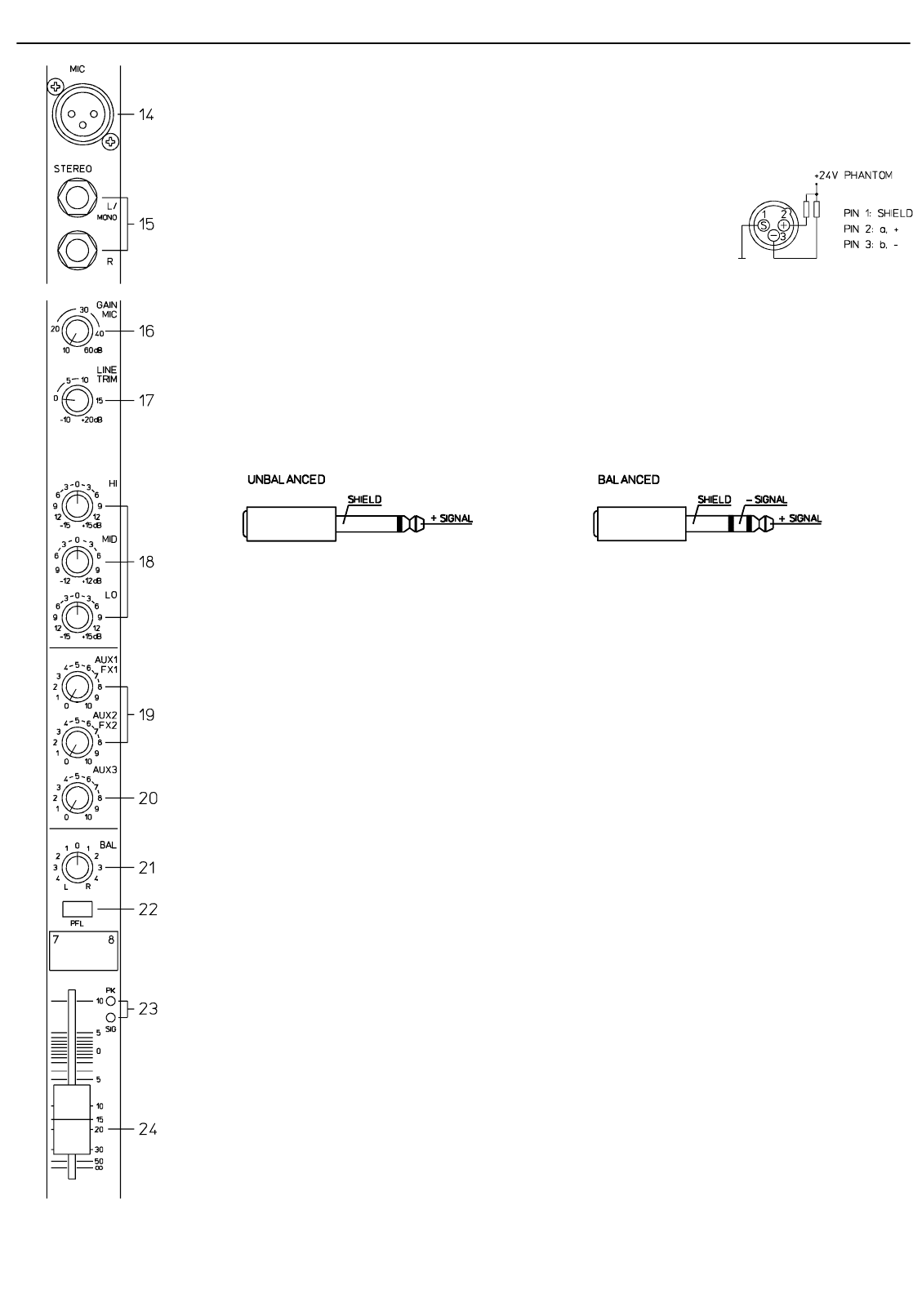
Since most features of the stereo inputs are virtually identical to those of the monaural inputs, we will not discuss
their functions in detail again. Thus, we only point out the differences and ask you to refer to the paragraphs in the
first chapter of this owner’s manual.
14. MIC
Like their monaural counterparts the stereo input channels of the PSX incorporate
extensive circuitry and electronically balanced XLR-type connectors for the connec-
tion of low impedance microphones. Whether your setup is more microphone-ori-
ented or you have more line level sound sources to connect, you can always use
the full amount of input channels, provided by your PSX. The functioning principles
were already discussed in detail in the previous chapter.
15. STEREO INPUT L/MONO R
Electronically balanced inputs for the connection of musical instruments with stereo output, like keyboards and
drum machines, Electric guitars and basses with an active outputs, as well as all other equivalent sound sources
with high level outputs, like additional mixing consoles, FX units, CD players, etc.
The stereo LINE input is meant for balanced or unbalanced sources with levels between –20dBu and +30dBu. For
the connection of external devices you can use monaural or stereo phone plugs which are in accordance to the
diagram below. If the external device is equipped with a balanced output stage, you should preferably use balanced
cables and plugs, since this type of connection provides better shielding against HF induction and external noise.
In case you want to connect a monaural source to a stereo input channel, plug it into the L/MONO input. The signal
gets internally routed to both channels. For further information, please refer to the chapter “INPUT/MONO”.
16. GAIN MIC
Rotary control to adjust the MIC inputs’ sensitivity, providing the possibility to optimally match the incoming signals
with the mixer’s internal operation level. The MIC GAIN control is only active for the XLR-type connections of the
stereo input channels.
Adjustment and functioning of these controls are identical to those of the monaural inputs.
CAUTION: The MIC GAIN control of an unused microphone input should always be set to its minimal marking.
Otherwise the noise of the inactive input is added to the audio signal of the corresponding LINE input, which could
lead to unnecessary extra noise at the main output, becoming clearly audible in program breaks.
17. LINE TRIM
These rotary controls are used to match the incoming line level signals with the operational level of the PSX. The
total adjustment range is 30dB. Unity gain – no amplification (0 dB) – is achieved at the 0dB mark. The control
offers a level reduction of the incoming signal by –20dB and an amplification of +20dB. This range is wide enough
to allow the connection of most professional, semi professional, and even hi-fi audio sources.
For further details on how to adjust the LINE TRIM control, please refer to paragraph 4. GAIN.
If you use a keyboard as sound source on one of the stereo inputs, make sure that no split zones or layers with
channel separation are activated. Otherwise the stereo channel mapping will appear like it is set on the keyboard
and you will not have the opportunity to re-position the sound in the overall stereo image, using the controls of the
mixer. The better alternative to connect a keyboard with pre-programmed channel mapping is to use two adjacent
monaural input channels, leaving you the option to place the sound in the final mix via PAN controls.
One more tip, in case you desperately need another input and all channels of the PSX are already in use:
The microphone input and the phone plug-type inputs are electrically separated from each other. Each input is
equipped with its own gain control – respectively trim control, providing you with the possibility to connect a LINE
level source in addition to a microphone. Of course, the two sources share all other controls. Consequently,
separate adjustments are not possible. This option is only meant as a subsidiary function and can be used when
there is absolutely no other alternative.
INPUT/STEREO
8 of 32


















